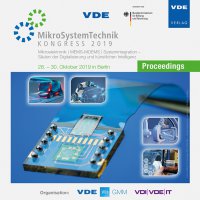Functional carbon nanotubes for MEMS applications: Miniaturized strain sensor and black coating for infrared devices
Konferenz: MikroSystemTechnik 2019 - Kongress
28.10.2019 - 30.10.2019 in Berlin, Deutschland
Tagungsband: MikroSystemTechnik 2019
Seiten: 4Sprache: EnglischTyp: PDF
Persönliche VDE-Mitglieder erhalten auf diesen Artikel 10% Rabatt
Autoren:
Boettger, Simon (Technische Universität Chemnitz, Center for Microtechnologies, Reichenhainer Str. 70, 09126 Chemnitz, Germany)
Bonitz, Jens (Fraunhofer Institute for Electronic Nano Systems (ENAS), Technologie-Campus 3, 09126, Chemnitz, Germany)
Al-Falahi, Falah (Fraunhofer Institute for Photonic Microsystems (IPMS), Maria-Reiche-Str. 2, 01109 Dresden, Germany)
Schulz, Stefan E.; Hermann, Sascha (Technische Universität Chemnitz, Center for Microtechnologies, Reichenhainer Str. 70, 09126 Chemnitz, Germany & Fraunhofer Institute for Electronic Nano Systems (ENAS), Technologie-Campus 3, 09126, Chemnitz, Germany & Technische Universität Chemnitz, Center for Advancing Electronics Dresden (cfaed), 09126 Chemnitz, Germany)
Inhalt:
Carbon Nanotubes are considered as a promising new functional element in advanced MEMS and emerging NEMS seeking for further miniaturization, high efficiency as well as new functionality and new integration possibilities. In order to overcome technological barriers for industrial implementation, the center for microtechnologies (ZfM) at the technical university of Chemnitz together with the center for advancing electronics Dresden (cfaed) established a nanotechnology platform enabling manufacturing of nanodevices and system integration directly compatible with wafer-level silicon technologies. In part of this platform we demonstrate here a MEMS based technology which was extended with the intergation of carbon nanotubes. At the example of a integrated miniaturized strain sensor, we show the technological compatibility of a CNT-transistor device modul with conventional manufacturing routines for thin Si-membranes applicable in pressure, tactile or acustic sensors. In depth studies on the piezoresistive sensor expose gauge factors of up to 600 and operation regimes for highest sensitivity. On the other hand we present a technological path where the integration of CNTs into MEMS devices is achieved via direct site-slective growth of dense CNT forrests with chemical vapor deposition at temperatures below 500deg C. This represents in particular applications which benefit from structures with superior surface-to-volume ratios, broadband optical absorbance or advanced thermal management as found for example in energy storage devices, gas sensors or infrared sensors and emitter. Here we show a fully integrated CNT-based black coating for infrared devices in a MEMS membrane structure, which has an IR absorption above 95% in the range of 2 to 12 µm wavelength.


